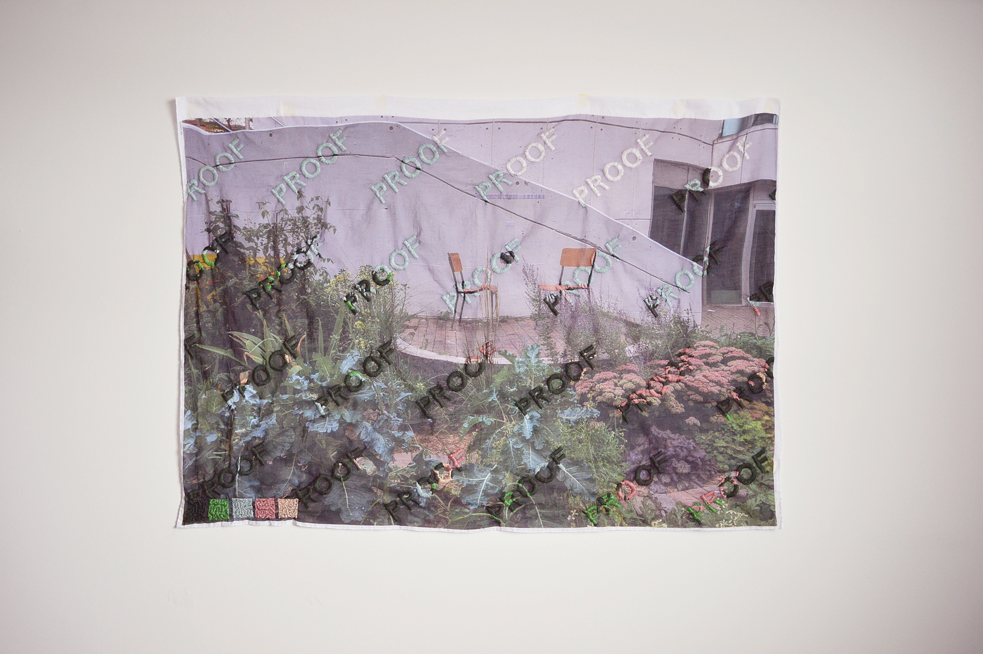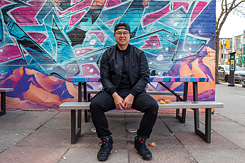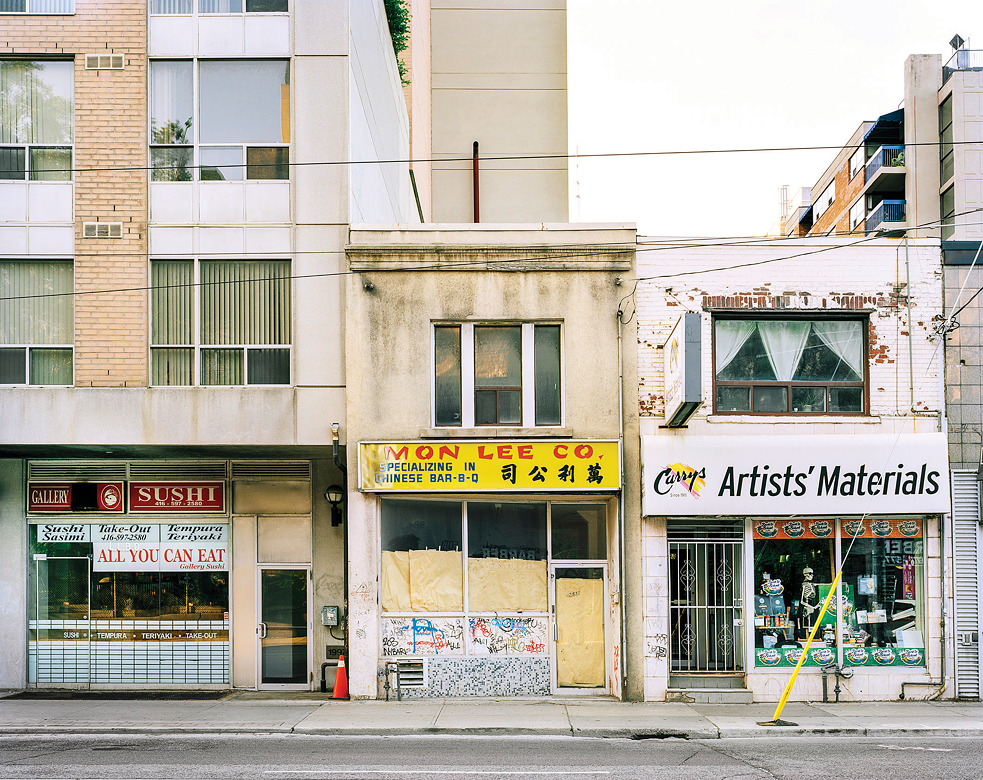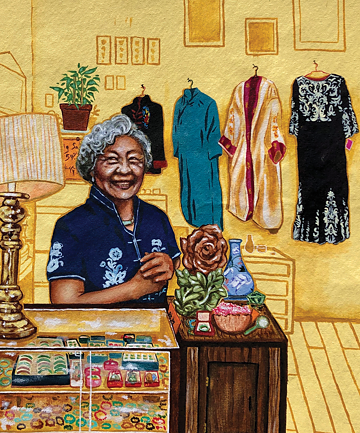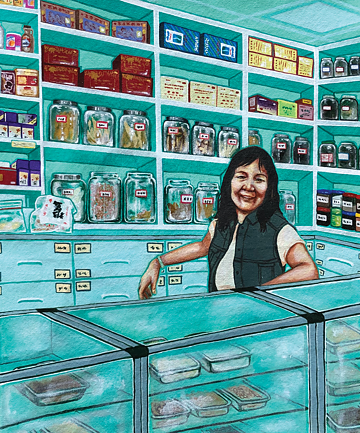Asian-Canadian Arts Collective
Tea Base
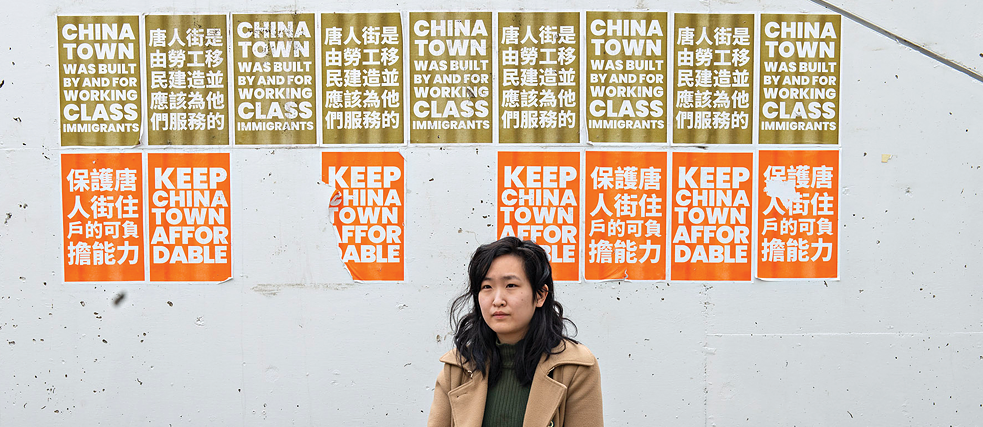
Through embroidery, painting, photography and even gardening, the work of the Asian-Canadian arts collective Tea Base explores the spectrum of their experiences, from anti-Asian racism to what one of them, illustrator Christie Jia Wen Carrière, describes as “the joy of community in Chinatown”
By Samantha Edwards
Chinatown was one of the first neighborhoods in Toronto to feel the impacts of COVID-19.
In January 2020, months before restaurants were officially ordered to shut down, the Asian restaurants that dot Spadina Avenue and cluster around Dundas Street West began experiencing a rapid decline in customers and an increase in harassment.
That same month, Asian-Canadian groups like the Chinese Canadian National Council for Social Justice (CCNC-SJ) expressed their fears of a spike in anti-Asian racism, recalling the wave of xenophobia during the 2003 SARS outbreak.
Unfortunately, these fears were realized. Hate crimes against Asian Canadians have drastically increased over the course of the pandemic. According to a recent report from the CCNC, nationwide there have been 1,150 cases of anti-Asian racist attacks over the past year. In some Canadian cities, that represents an increase of 600 to 700 per cent. Women were the victims in 60 per cent of all reported cases and 10 per cent of all attacks included being coughed at or spat on. People aged 55 and older were 57 per cent more likely to report being physically assaulted than young adults. On top of grappling with anxiety over the pandemic, the threat of violence looms large for so many Asian-Canadian communities.
It was only after the horrific shooting in Atlanta, when a white man murdered eight people, six of them Asian women, that the dangerous reality of anti-Asian racism finally broke into the mainstream discourse, igniting conversations about xenophobia, misogyny and the long history of racism against Asian people in North America.
But while these issues are getting more attention now, they’ve been subjects Asian-Canadian artists have been interrogating for a long time. Florence Yee, Christie Jia Wen Carrière and Morris Lum, all of whom have connections to Toronto’s Chinatown, use their art practices to explore ideas of the perpetual foreigner, the fetishization of Asian women, class and immigration, and the sanctity of space.
These interviews happened prior to the attack in Atlanta, but our conversations paralleled many of the conversations that have emerged in its wake.
“With the amount of distance I have as a third-generation person, I like to leave room for doubt [in my art]”—Florence Yee
Located in the lower courtyard of the Chinatown Centre mall at Cameron and Spadina, nestled along a curving staircase, the Anti-Displacement Garden grows zucchini, corn, broccoli, lemongrass, bok choy, mint and other herbs. Tea Base, a community arts space located inside the mall, built the garden in the summer of 2019, turning a pile of bricks into an intergenerational neighbourhood hub.
The garden is featured in visual artist and Tea Base co-director Florence Yee’s recent piece, “PROOF— Chinatown Anti-Displacement Garden” (2020). Yee photographed the lush garden last summer and had it printed on white cotton fabric. With the word “PROOF” hand embroidered across like a watermark, the piece riffs on how something unfinished cannot be claimed or owned, and the idea of proof as evidence of queer spaces existing within Chinatown.
Born in Montreal and now based in Toronto’s Chinatown, Yee’s work uses text, language and labour-intensive ways of creating to work through feelings of self-doubt, authenticity and displacement. For example, their work “Selected Hauntings” is a collection of micro stories – “She was worried about appropriating her own culture” and “He yelled ‘go back to Chinatown,’ I finally belonged in Montreal” – embroidered onto translucent silky gauze. Each story comments on the internal anxieties of racialized artists in the diaspora.
“I think those kinds of thoughts are very common, but are unsaid because there’s an amount of cultural confidence that you’re supposed to go into a space with if you are to be seen as credible,” says Yee. “With the amount of distance I have as a third-generation person and dwindling sources of knowledge around me, I like to leave a lot of room for that doubt and uncertainty.”
During the pandemic, Yee has been thinking about how to make art in safe ways that allow them to still connect with their neighbourhood and other artists. They’ve made a series of “Seeking” posters about unattainable desires they’ve hung up around Chinatown, and a ceramic tangerine DIY kit, made in collaboration with fellow artist Arezu Salamzadeh, that they’ve been mailing to friends and family. And when the weather finally warms, Yee will be back in the Anti-Displacement Garden, pulling out dead weeds and debris, turning the soil, and planting new seeds for the season.
“The garden is an example of how taking care of a space creates some connections between us, the neighbouring businesses and the people that come by,” says Yee. “I think there’s also a parallel in the way old grannies will just sell their vegetables on Spadina. Unfortunately, they’re not there anymore, but I hope they come back.”
Over eight years, he photographed Chinatowns from San Francisco to Halifax. “I want to better understand lineage” — Morris Lum
Over the past eight years, Toronto-based photographer Morris Lum has been travelling to Chinatowns across North America to document their unique architecture and community institutions like long-running mom and pop shops, beloved restaurants and significant cultural hubs that are invisible to passersby. So far, he’s photographed Chinatowns in Toronto, Victoria, Vancouver, Calgary, Edmonton, Winnipeg, Ottawa, Montreal, Halifax, San Francisco, Los Angeles, New York and Boston.
Lum’s goal for the project was to build a visual archive of Chinatowns and track how they’re evolving due to the impacts of gentrification, economic changes and the settlement trends of new generations of Chinese immigrants. “Originally, Chinatowns were a refuge for new immigrants. It was the only place where people spoke the same language, so they really needed that community support to [access] services, find a job, learn English and be able to survive. The earlier generation was more working class and needed to stick together,” says Lum. “Newer immigrants can afford to move to nicer neighbourhoods [in the GTA], their English is a bit better and they’re [of] a higher class, so they’re more equipped to adapt.”
In addition to creating a photographic archive of Chinatowns, Lum is also interested in documenting the architecture that shows how the Chinese diaspora has settled across the suburbs. It’s a project that’s rooted in trying to better understand his family history. “I’m Chinese, but I was born in Trinidad and grew up in Mississauga,” says Lum. “I want to better understand lineage. How did the Chinese end up moving to Trinidad? I still don’t have the answer to that.”
For now, though, his lens is focused on the Chinatowns built by North America’s first Chinese immigrants, partly to document the restaurants and shops before they disappear, and partly to build an archive that can help future generations. “I grew up in the suburbs, and I didn’t know any of the history of Chinatowns,” says Lum. “But doing this project, I recognized I needed to learn that history, learn why Chinatowns exists and why [they made] it easier for my generation to move to Canada.”
Her paintings of shopkeepers in Chinatown Centre mall “came out of a desire to combat racial pain without eliminating the presence of race” — Christie Jia Wen Carrière
Over the last few years, painter and illustrator Christie Jia Wen Carrière, who also goes by Chris, has explored her Chinese-Canadian identity and the long history of sexualizing Asian women. She’s painted self-portraits of herself in traditional Chinese clothes, created mixed-media works exploring cultural appropriation and the white male gaze and drawn an illustration of a woman in a red cheongsam lounging in a takeout container of noodles, in response to a racist handbag by Kylie and Kendall Jenner that was shaped like a Chinese restaurant takeout box.
In her more recent work, however, Carrière is finding ways to showcase joy within the Chinese community and in Chinatown.
Last year, Carrière walked through the Chinatown Centre and photographed the shopkeepers of various small businesses tucked away in the mall. With translation help from other members of Tea Base, Carrière, who is the co-creative director of the art space, chatted with the owners, who shared stories about the mall and showed off unique items inside their stores. “In the jade shop, [the owner] showed us these really old antiques, like Ming Dynasty pornography sketched onto a little pot,” says Carrière. “Everyone’s always saying it’s a dead mall. But there are all these really interesting gems in there.”
The “Chinatown Mall Project” is a series of vibrant paintings featuring the shopkeepers, like the grey-haired woman behind a display case of pretty jade rings, the candy store owner smiling in front of rows of Pocky and Hello Kitty-branded snacks, and the medicine shop owner who’s surrounded by glass jars filled with traditional Chinese herbs.
The project was inspired by the term “trauma clown,” which was coined by South Asian artist Vivek Shraya to describe how marginalized artists are often expected to use their trauma in their work to be more marketable. Building off this idea, Carrière wanted to highlight the joy she saw in her community. “The project came out of a desire to combat racial pain without eliminating the presence of race,” says Carrière. “I want to depict the joy of community in Chinatown.”
